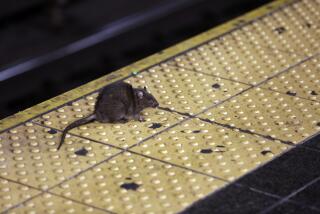A Small Rodent That Played a Large Role
RANCHO SANTA MARGARITA — Exploring the concept of death hardly represents the typical lesson plan for an elementary school teacher or his third-grade students.
After all, exactly how does one confront small children--who in many ways embody the meaning of life and its joys--with a topic considered taboo to many adults?
Enter Dinky the rat.
Dinky, a black-and-white female rat, was the classroom pet for Scott Leaman’s students at Trabuco Mesa Elementary School in Rancho Santa Margarita.
Housed in a glass cage in the corner of the room, Dinky C. Reeboks--her full name, voted on by Leaman’s former students in Carlsbad--was taken home by different students each weekend to help teach them the responsibility of caring for another being.
Last November, the affectionate rodent with a reputation for licking people’s faces became a cause celebre when she developed a potentially fatal mammary tumor.
The growth was successfully removed through the volunteer work of veterinarian Ron Kelpe, but because there was a chance Dinky might not survive the surgery, Leaman had prepared his class for her possible death.
He checked out a library book called “Ten Good Things About Barney,” which discussed the death of a family’s pet cat. It focused on the concept that the grieving children should remember the good things about their pet rather than dwelling on the tragedy of his death.
But Dinky survived.
Kelpe even made a special trip to the classroom to remove her sutures while the class gathered around and watched, wide-eyed. And Leaman figured that the children, in the excitement of having Dinky back in their midst, had dismissed the idea that their pet would one day die.
Then a couple of months later, Leaman noticed a change in the 4-year-old Dinky, who was nearing the average life span for a rat.
A subsequent check-up by Kelpe confirmed Leaman’s hunch. The diagnosis: cancerous tissue had spread to her lungs.
“The kids would hold her and say that she was getting skinny,” Leaman recalled. “Finally, she was getting down to skin and bones and I decided to keep her at my home.”
Although Kelpe tried administering large doses of antibiotics, hoping that they would act as a form of animal chemotherapy, Dinky responded only for a short period of time before her condition worsened.
With Dinky’s death imminent, Leaman told the students their pet was very sick. But he was careful not to make her death a certainty at that point, in case the antibiotic treatments worked.
“I didn’t want to come in and tell the kids Dinky was going to die, and have them think, ‘This is it,’ then be wrong if she got better,” Leaman explained.
As Dinky grew thinner and more listless, Leaman decided to have Dr. Kelpe put her to sleep in February.
He worried how the children would react to the tragic news. To make matters worse, a few of the students had persuaded their parents to buy them pet rats based on Dinky’s example.
“It was the most shocking thing,” Leaman said. “The kids handled it a lot differently than I thought they would.”
Initially, Leaman said, there wasn’t a lot of reaction.
Then, as part of an ongoing program for the kids to keep journals, he noticed some emotional fallout in their writing. One student wrote about crying over Dinky’s loss; others said they missed their class pet.
“It started oozing out in different places,” Leaman said. “And although there might have been a lack of observable emotions, there was not a lack of feeling. I think I prepared them. It wasn’t like we said everything was OK and then she was dead the next day.”
A few weeks later, Leaman considered replacing Dinky. The students debated: Some wanted a rat that looked exactly like Dinky, others wanted a totally different animal.
Then, while passing a pet store window, Leaman spotted a beige-and-white rat and bought it on impulse.
As he did with Dinky, he allowed the children to vote on a name.
And, in the same glass cage in the same corner of the classroom, Peaches Snowball Dinky carries on the legacy of her predecessor. She plays with the students, climbing on their arms, necks and up their long-sleeved shirts. She teaches them the responsibility of caring.
Dinky, meanwhile, taught the students a valuable lesson to carry them to adulthood: the idea of realizing that death is as much a part of life as birth, and that the memories of a dead loved one don’t have to cause pain.
“I’m glad Mr. Leaman bought Peaches,” said 8-year-old Billy Glas, his freckled face and blue eyes solemn as he philosophized about the class pet. “Because if we didn’t have Peaches, we’d probably forget about Dinky.”
More to Read
Sign up for Essential California
The most important California stories and recommendations in your inbox every morning.
You may occasionally receive promotional content from the Los Angeles Times.









